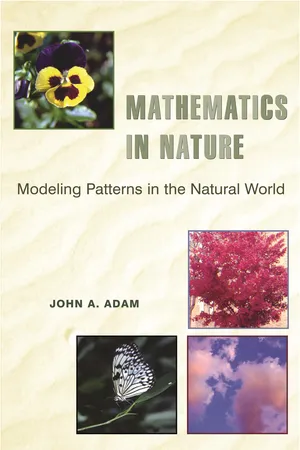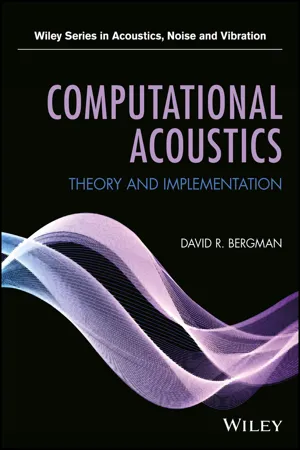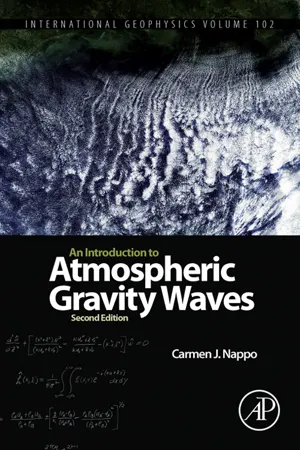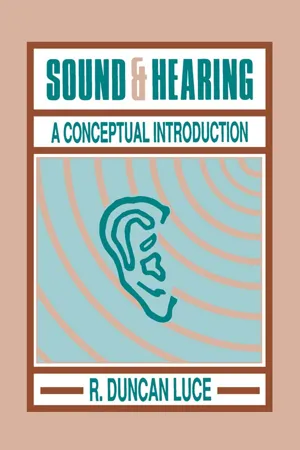Physics
Linear Wave
A linear wave is a type of wave that follows the principle of superposition, meaning that the overall wave is the sum of the individual wave components. In a linear wave, the amplitude and frequency remain constant, and the wave propagates without distortion. This type of wave is commonly studied in physics and has applications in various fields such as acoustics and optics.
Written by Perlego with AI-assistance
Related key terms
Related key terms
1 of 4
Related key terms
1 of 3
5 Key excerpts on "Linear Wave"
- eBook - ePub
Mathematics in Nature
Modeling Patterns in the Natural World
- John Adam(Author)
- 2011(Publication Date)
- Princeton University Press(Publisher)
does occur at the surface.)In the example of the pond, the ripples spread outward over the surface carrying energy with them, but if we watch, say, a cork on the surface we see that it (and hence the water) does not move with the waves, but bobs up and down periodically. It is found that whatever the nature of the medium through which the waves are transmitted, whether it be air, a stretched string, a liquid, an electric cable, or deep space, these two properties are common to all types of wave motion and enable them to be described.Mathematically, they are all governed by a certain partial differential equation called the wave equation, and the solution of this equation when interpreted appropriately is the mathematical description of the corresponding idealized physical phenomenon of wave motion. It must be emphasized that in this chapter we are dealing with what is called linear theory . This means that the wave amplitudes (or particle displacements) are sufficiently small (technically they are infinitesimal) that all their squares and higher powers can be neglected in the subsequent mathematical analysis. This is a severe approximation with great limitations, to be sure, but nonetheless linear theory has provided some very powerful and useful results because the mathematics is generally more tractable than for nonlinear theory, and therefore amenable to analytical techniques. Some examples dealing with nonLinear Waves will be discussed in chapter 9 .Waves can be separated basically into two distinct types: transverse waves and longitudinal waves. Transverse waves may be conveniently illustrated by means of our pond example; we have already noted that, whereas the waves or ripples gradually move outward in ever-increasing circles across the surface of the pond, the cork, initially at rest, bobs up and down several times, eventually coming to rest again as the waves pass on. The cork merely serves as a convenient indicator of the behavior of the fluid beneath it, that is, the (nearly) vertical motion of the water particles. It is evident that when the ripples reach the point where the cork is located, the water particles suddenly acquire energy that they retain for only a short time and then relinquish to horizontally neighboring particles as the waves pass on. It is therefore the energy that travels in a horizontal direction with the ripples, not the water itself, although for a time the water particles acquire a certain amount of kinetic energy in the vertical direction. - eBook - ePub
Computational Acoustics
Theory and Implementation
- David R. Bergman(Author)
- 2018(Publication Date)
- Wiley(Publisher)
Sections appear as follows. The first section describes wave phenomenon without any reference to the medium. This is to establish basic vocabulary. The next section is a review of the coupled mass–spring system from classical mechanics along with a description of normal modes of vibration. The limit to a continuum is taken to arrive at an equation for wave propagation in one spatial dimension. Following the treatment of one‐dimensional waves is a presentation of the equations for wave propagation in three‐dimensional elastic solids. This presentation starts with the stress–strain relation, Hook’s law, and continuum mechanics and passes to a second‐order wave equation. The next section presents a detailed derivation of the linear first‐ and second‐order wave equations derived from the equations of fluid mechanics. This will be the foundation for the discussion of modeling methods for describing the acoustic field. This section introduces a novel way of looking at the differential operator in the wave equation, appearing in the acoustics literature in the late 1970s, which uses concepts from differential geometry and tensor analysis. Following waves in fluids is a very brief section on thin plates and rods, followed by a description of phonons from solid‐state physics. After a survey of the various manifestations of the wave equation, this chapter concludes with a brief section on tensors and manifolds to serve as preparation for later chapters.3.2 General Properties of Waves
This section introduces some basic concepts used to describe wave phenomena without reference to a specific type of physical wave. The two most common wave phenomena are optics and acoustics; hence some jargon related to waves is derived from these subjects. Waves share much in common with the phenomenon of oscillation, or periodic motion. A perfect example is waves traveling on the surface of a body of water. Looking out at an ocean or lake, under the right conditions, if one were to sketch a picture of the water surface, it might look like a set of long parallel crests separated by valleys. If pressed to give a description of the terrain of the water surface, one might say it rises and falls with a fixed height and at fixed intervals in a specific direction on the surface of the water. The apparent fixed height is related to the amplitude of the wave, while the fixed horizontal distance between crests or valleys is called the wavelength. Looking at the waves as they travel across the water surface, one would likely see a fixed spatial profile move in a well‐defined direction at a constant speed. In short, based on observation, it would appear that this collection of crests has a structure and moves as an entity on the water. This structure is not eternal, as it will eventually crash into the shore or encounter obstacles, changing direction and shape. However, for the time that it appears to exist, the parameters amplitude and wavelength describe this shape, and “moving with constant velocity” describes its behavior. A reasonable mathematical description of this profile is - eBook - ePub
- Carmen J. Nappo(Author)
- 2012(Publication Date)
- Academic Press(Publisher)
et al. , 2004). Yet in spite of these difficulties, the linear theory is still useful, and provides a first-order estimate of most wave phenomena. Also, the simplicity of the linear theory gives an understandable picture of the wave processes and observations. Relatively few people can think and work in a nonlinear world.Linear theory describes the possible disturbances of an existing state of uniform motion. A dynamic theory describes the consequences of forces acting to change the motions of a system. Thus, a dynamic theory is nonlinear. What this means is that a linear analysis must begin with a known uniform state of motion and energy. Linear theory cannot predict the motions of waves in a fluid, it can only predict possible wave states in the fluid. However, the possibility of waves is not a sufficient condition for waves. This is important. We shall see there are conditions where the linear theory describes waves, but observations show no evidence of waves as described bySmith et al. (2002)in connection with mountain lee waves. In this case, the linear theory either fails or some acting forces have not been considered. In other cases, observations show waves where the linear theory describes no waves. This leads to an ‘updating’ of the linear theory. An example of this is the observations of wave disturbances in the ionosphere and their explanation by Hines (1974) .2.2 The Taylor– Goldstein Equation
The Taylor–Goldstein equation is the wave equation for linear gravity waves. We consider the Euler equations for irrotational, frictionless, and non-heat conducting, i.e. , adiabatic flow. The velocities in the directions are respectively. Here and throughout most of this book we shall use a two-dimensional reference plane. Extension to three dimensions is straightforward. Under the Boussinesq approximation the governing equations are:(2.1)(2.2)(2.3)(2.4)Equations (2.1) and (2.2) express the momentum in the and -directions respectively. Equation (2.3) is the continuity equation, and (2.4) represents the conservation of mass. We linearize (2.1) – (2.4) according to(2.5)We also assume that the background flow is in hydrostatic balance. Then (2.1) – (2.4) - eBook - ePub
- Myeongkyu Lee(Author)
- 2019(Publication Date)
- Apple Academic Press(Publisher)
CHAPTER 1Electromagnetic Waves
1.1 MATHEMATICS OF WAVE MOTION
1.1.1 ONE-DIMENSIONAL WAVE EQUATION
A wave can be described as a disturbance that travels through a medium from one position to another position. In physics, waves are time-varying oscillations of a physical quantity around fixed locations. Wave motion transfers energy from one point to another. A wave can be transverse or longitudinal. Transverse waves such as electromagnetic waves occur when a disturbance generates oscillations that are perpendicular to the propagation of energy transfer. Longitudinal waves (e.g., sound waves) occur when the oscillations are parallel to the propagation direction. Waves are described by a wave equation that sets out how the disturbance proceeds over time. Consider a transverse pulsed wave traveling in the positive x-direction with a constant speed v, as shown in Figure 1.1 . Since the disturbance is a function of both position and time, it can be written asψ = f(⋅x , t)(1.1) We here deal with a wave whose shape does not change as it propagates through space. The shape of the disturbance at any time, say t = 0, can be obtained by holding time constant at that value.ψ(x , t)|t = 0= f(= fx , 0)( x )⋅(1.2) Figure 1.1 shows the wave profiles at t = 0 and t = t, that is, f (x, 0) and f (x, t). They represent the shapes of the disturbance taken at the beginning and end of a time interval t. We now introduce a new coordinate x’ that is defined asx ′= x − v t .(1.3) In this new coordinate system, the disturbance ψ = f (x´) is no longer a function of time and looks the same at any value of t as it did at t = 0 in the original stationary coordinate system. It follows from Figure 1.1 - eBook - ePub
Sound & Hearing
A Conceptual Introduction
- R. Duncan Luce(Author)
- 2013(Publication Date)
- Psychology Press(Publisher)
c , that is a characteristic of the medium.Now imagine the wave as existing indefinitely. Then, at any instant of time, the amplitude will form a sine wave in space (due to the pulse propagation) as well as one in time. This fact is familiar from surface waves in water. You can see the spatial patterns of circles, and if you fixate at a particular point you can watch the temporal change as the water rises and falls.DEFINITION: The wavelength of a wave is the spatial distance between successive zero crossings of the amplitude. It is symbolized by λ (see Fig. II.11 .). Observe that wavelength plays an analogous role in describing the wave in space to that of period in describing it in time.FIG. II.11 The wave in space that corresponds to a transverse sinusoid.3.2.2 Relation Among Speed, Frequency, and Wavelength . We know the following:● Each pulse moves through space at speed c .● The distance between successive zero-crossings of the wave is λ.● The time between successive zero-crossings is T .Thus, suppose we mark an imaginary point on the wave at time 0, shown as a dot in part a of Fig. II.12 . Then after time T has elapsed, one can ask where that point has gotten, as shown in part b. Because the speed of propagation is the ratio of the distance traversed by the time taken to do so, and in T seconds it travels λ units of distance, we necessarily have the important relation:(6) Note that the unit of the speed c must be the unit of distance used to measure the distance divided by the unit of time used to measure the period, T
Index pages curate the most relevant extracts from our library of academic textbooks. They’ve been created using an in-house natural language model (NLM), each adding context and meaning to key research topics.
Explore more topic indexes
Explore more topic indexes
1 of 6
Explore more topic indexes
1 of 4




